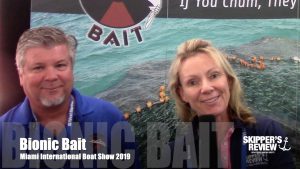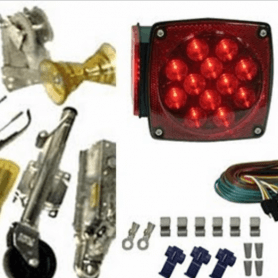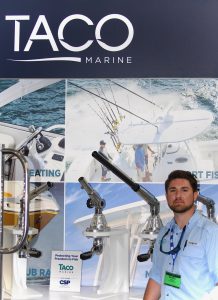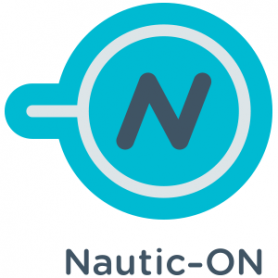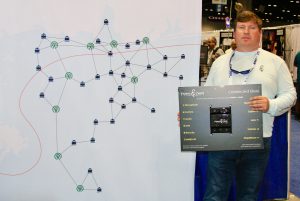At the Miami International Boat Show 2019, I caught up with Patrick Lynch, owner of Bionic Bait, largest bait supplier to South Florida fisher people. Patrick talks about how the most popular bait, Ballyhoo, is flourishing, what kind of nets they use. He explains why Bionic Bait gets a permit to fish over certain reef spots, how long it takes to make a big, big net and what happens when the weather is not cooperating.
Quiet Version Of Bionic Bait.
SKIPPER’S REVIEW: Hey Sarah O’ Kelly here with Skipper’s Review T.V. I’m at the Miami InternationalBoat Show 2019 and I’m here with Patrick Lynch from Bionic Bait. Bionic Bait is one of the main bait fish suppliers down here in South Florida for sport fishing. Patrick, what does it take from the beginning to the end. How do you actually go out and catch the fish or do you farm the fish, where do the fish come from?
BIONIC BAIT: Well we do have a boat that catches them and we buy from other fishermen. We have a processing room with 25 people that just pack fish, size them, put them in bags, vacuum pack them, blast freeze them. There are seven trucks on the road, covering the entire state of Florida. Every day a truck has a different route from Jacksonville to Key West to Tampa to Fort Myers to Orlando. We cover the entire East Coast.
SKIPPER’S REVIEW: So what about conditions, like weather conditions? Does weather affect your business in a detrimental way? Are you at risk a lot of the time of the year?
BIONIC BAIT: Like right now, this week the weather was very bad so our Ballyhoo boat didn’t get to fish for an entire week therefore our crew didn’t have much work for the that week. We live and die with the weather but as soon as it goes calm they go out, they catch them and then everyone works.
SKIPPER’S REVIEW: What is your most popular baitfish?
What is the most popular bait fish?
BIONIC BAIT: Ballyhoo, we are the largest Ballyhoo producer in the world that’s our main fish, but we have a 125 different items that we sell to bait and tackle stores, marinas this type of thing.
SKIPPER’S REVIEW: Have you noticed incline, decline in baitfish over the years?
BIONIC BAIT: No, we worked with the state and with the law, our nets are very clean, we have less than one tenth of one percent by-catch. Bionic Bait is the only commercial fishery that’s still allowed to fish on the reefs. We self regulated ourselves about 10-12 years ago. Bigger boats were getting in it so we cut off the daily limit of catch and closed a month. The stocks are healthier than they’ve been in 50 years, they’re healthy as healthy can be.
A trip limit is how much the boat can catch per day. So we reduce the trip limit. We couldn’t catch just, you know, a million pounds in one day and and go out and catch a million pounds tomorrow. The catch is ten boxes a day and then we close. We still needed 3% reduction in the catch, When we closed August off that gave us our 3%. The scientific computer models put us in a path of sustainability. The Ballyhoo is as strong as it’s ever been.
What is the fine if the net catches or touches the reef?
Our nets don’t touch the reef. If our nets touch the reef, the reef will grab the net and with strong currents this can result in the net just tearing in half. A new net costs about $20,000. The last thing you want to do is touch the reef, big, big problem and a fine too. More than the fine it tears your net in half and you can’t buy nets you must build them yourself.
To build a net takes four or five guys about a month everyday working a forty hour week.
SKIPPER’S REVIEW: What size net would that build?
BIONIC BAIT: It builds a net about 500 yards long.
SKIPPER’S REVIEW: You goal is to catch a particular bait fish but other fish, I’m sure, or marine life gets caught in the net. What have you found gets caught?
What kind of by-catch gets caught in the net.
BIONIC BAIT: Needle fish and Hound fish, Ballyhoo predators. They attack and eat Ballyhoo, those are the only ones we catch. Sometimes in the springtime we will catch flying fish as well and that’s good because we sell the flying fish. Flying fish only come into spawn in like May, April or May and then they leave and are offshore again for the rest of the year. When they do come in, we catch them.
Our nets are surface skimming nets so we can circle dolphins and turtles. Everything is smart enough to just swim out from underneath the net. The net skims the top of the water, so even the Ballyhoo can swim underneath it if they want too. They’re not very high on the brain scale and they’re not too smart, they are at the bottom of the food chain. We have a permit to fish in the spots, regular people cannot at all. The spots are very small little places along certain reefs through out the Keys from Key Largo to the Dry Tortugas. We have a permit deficient, that’s how clean our fishery is. We can go in there and take the fish from the surface and move along. It doesn’t hurt anything. Those fish are all migrating through at that time of year, they don’t stick around, they’re here and they’re gone. They’re gonna start to head back to the north right now and they’ll go all the way up to Maine.
SKIPPER’S REVIEW: Interesting, interesting all right well Patrick thank you so much.
BIONIC BAIT: You’re welcome
SKIPPER’S REVIEW: Sarah O’ Kelly, Skipper’s Review T.V at the Miami International Boat Show 2019. I’m with Bionic Bait and Patrick Lynch.


